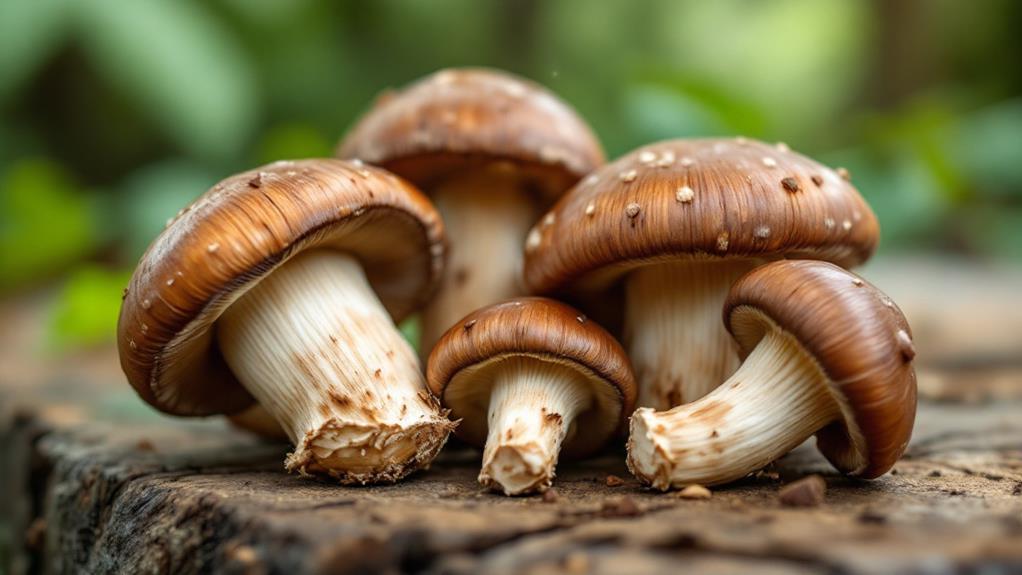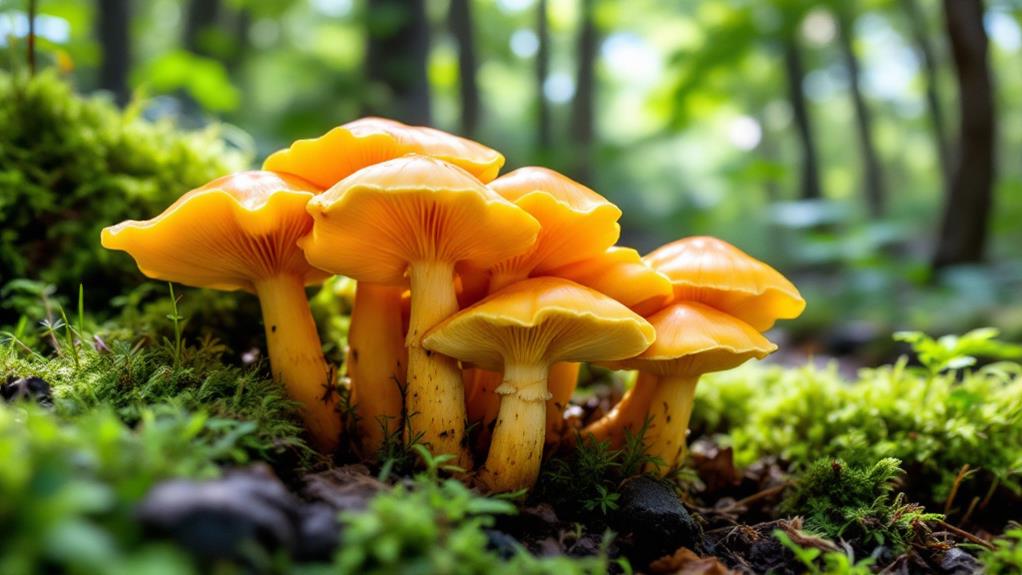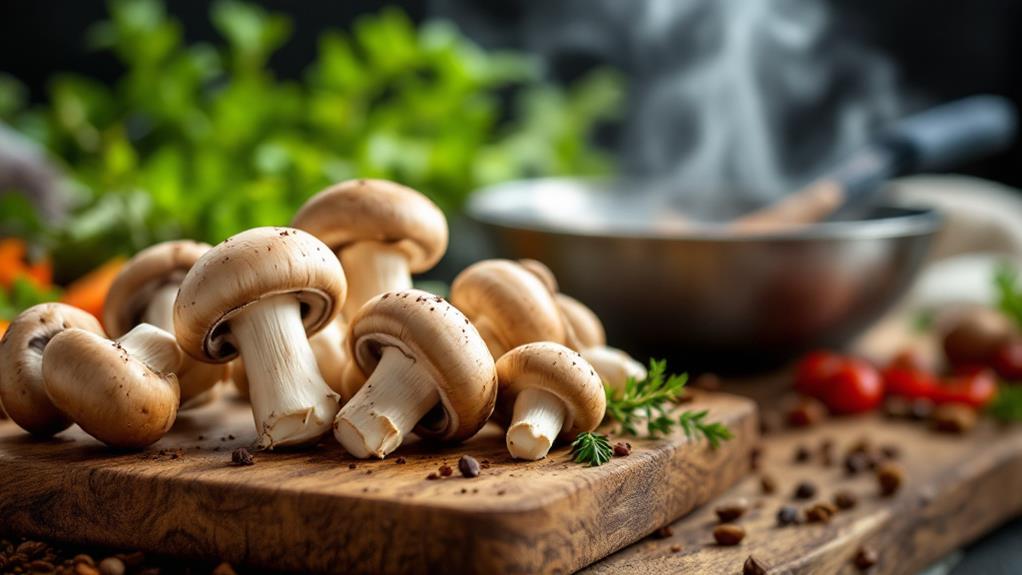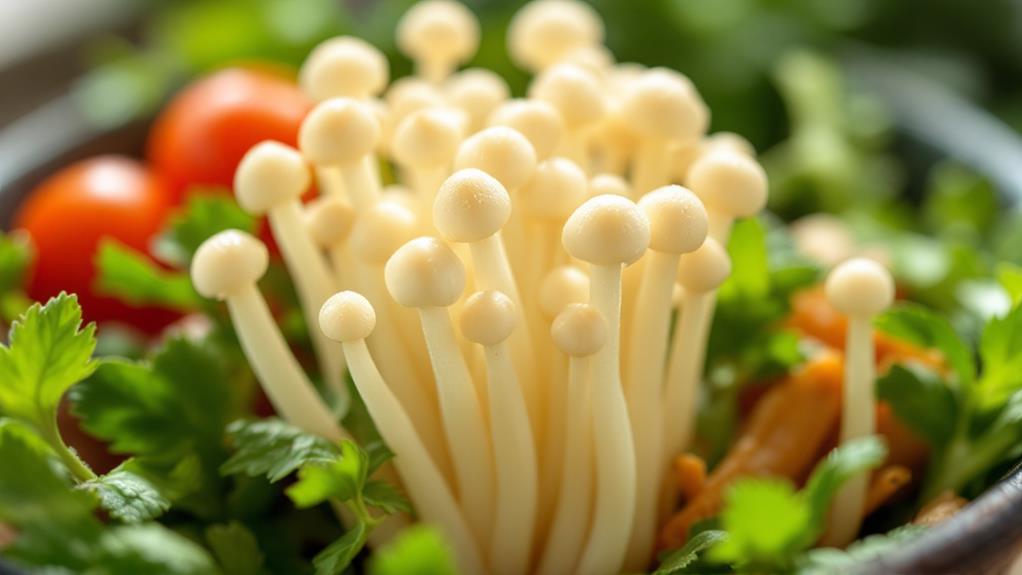A Complete Guide to Different Types of Mushrooms: Varieties and Uses
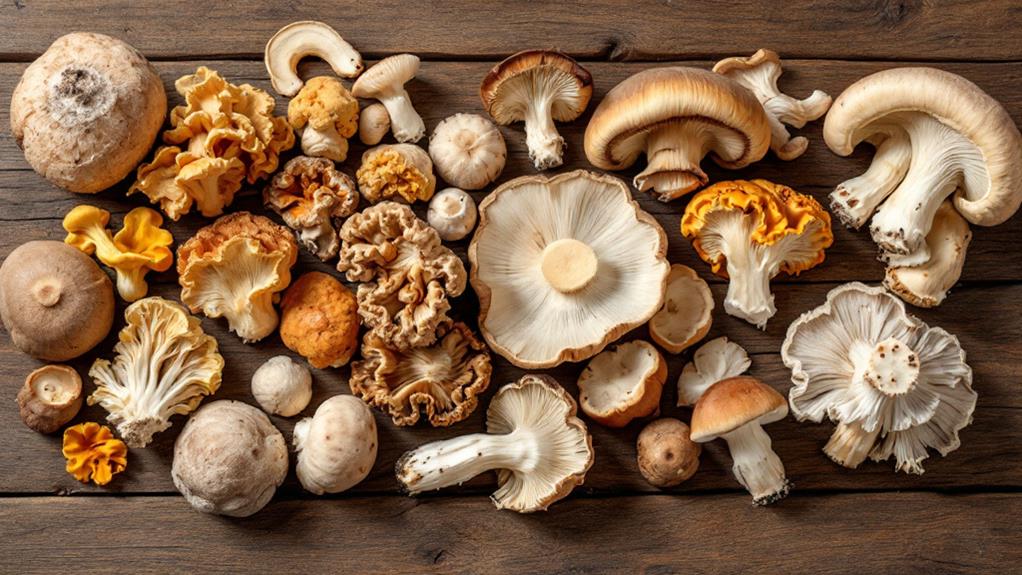
You're about to spice up your culinary expedition with an all-encompassing guide to mushrooms. From the widely-loved button mushrooms to the exotic truffles, each type offers unique flavors and textures for your dishes. You'll uncover shiitake for deep umami richness in stir-fries, oyster mushrooms as a fish sauce substitute, and luxurious porcini to enhance your risottos. Not only do mushrooms promise diverse flavors, but they also bring potential health benefits. Regardless of if you're crafting vegetarian meals or exploring wild varieties, mushrooms cater to every palate. By exploring further, you'll plunge into new ways to incorporate these versatile fungi into your cooking adventures.
Common Edible Mushrooms
Plunge into the world of common edible mushrooms, where culinary delight meets adaptability. Among these, button mushrooms reign supreme, accounting for 90% of U.S. consumption. Their mild flavor and firm texture make them a staple in soups, salads, and pizzas—truly showcasing their versatility. When you're looking for a richer taste, turn to shiitake mushrooms. Known for their deep umami flavor, they raise Asian dishes like stir-fries and soups to new heights, providing a satisfying depth that can transform a meal.
Don't overlook the charm of oyster mushrooms, either. Their delicate aroma and subtle taste make them a favorite in East Asian cuisine. They're often used as a vegan alternative to fish sauce, adding a gentle, savory note to numerous dishes. Regardless of whether you're making a stir-fry or a warm, comforting soup, oyster mushrooms deliver a unique flavor experience.
These common edible mushrooms, from the everyday button to the exotic shiitake and oyster, offer a world of culinary possibilities. By incorporating them into your meals, you're not just adding flavor but also embracing the rich variety of options available in the mushroom kingdom.
Gourmet Mushroom Varieties
Exploring gourmet mushroom varieties opens a door to a world of exquisite flavors and culinary sophistication. You'll uncover mushrooms like truffles, which are underground jewels with a distinct aroma that enhances any dish, often fetching prices up to $1,000 per kilogram. Porcini mushrooms, cherished in Italian and French gastronomy, offer a rich, woodsy flavor that transforms risottos and sauces into gourmet delights. Regardless of whether fresh or dried, porcini require a bit of preparation but reward you with their depth of flavor.
Consider these gourmet varieties:
- Chanterelle Mushrooms: With their trumpet-like shape and sweet, peppery taste, chanterelles are a rare find, often foraged from woodlands. They're perfect for delicate dishes like pastas and sauces, where their unique flavor shines.
- King Oyster Mushrooms: Known for their thick, meaty stems and earthy flavor, king oysters are versatile in gourmet cooking. You can slice them for stir-fries or grill them as a robust vegetarian option, adding a hearty touch to your meals.
- Black Trumpet Mushrooms: Dubbed the "poor man's truffle," these mushrooms boast a rich, smoky flavor. Their taste intensifies when dried, making them an exceptional enhancement to gourmet risottos.
Medicinal Mushrooms
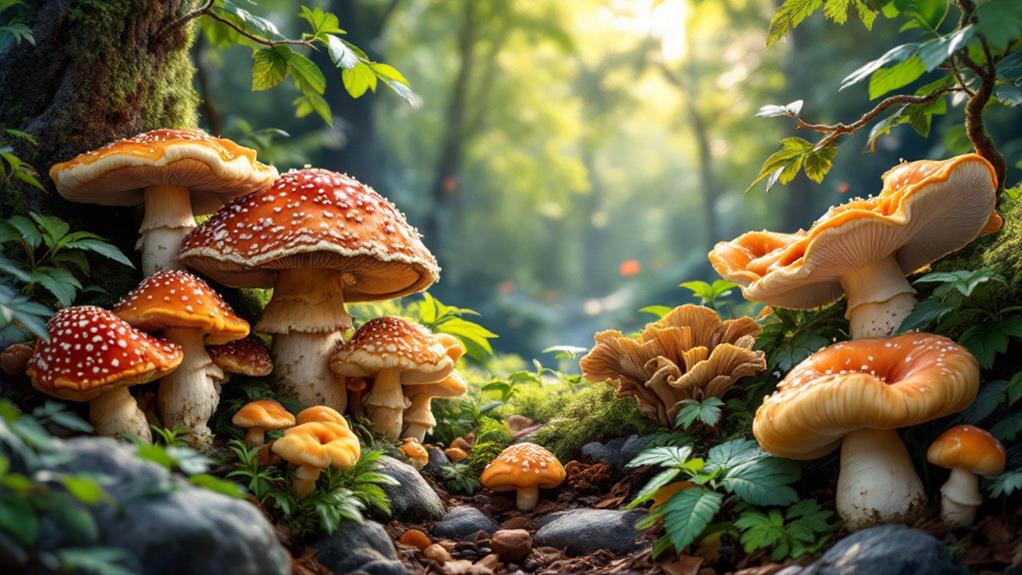
While gourmet mushrooms dazzle with their flavors, medicinal mushrooms offer significant health benefits that have been recognized for centuries. You'll find that medicinal mushrooms like Lion's Mane are particularly fascinating, as they support cognitive health and nerve regeneration. They contain unique compounds that stimulate nerve growth factor, which is key for maintaining a healthy nervous system.
Reishi, often called the "mushroom of immortality," is celebrated for its immune health benefits. It's traditionally used to promote longevity and general well-being. When you investigate Reishi, you're tapping into centuries of wisdom surrounding its potential to elevate the immune system.
Maitake mushrooms come into play with their beta-glucans, which may improve immune function. Studies have even examined their potential anti-cancer properties, making them a significant addition to your wellness routine. Turkey Tail is another powerhouse, rich in polysaccharopeptides. It's especially researched for supporting immune health in cancer patients, offering hope and resilience.
Lastly, Chaga mushrooms, typically enjoyed as a tea, are loaded with antioxidants. They have been linked to anti-inflammatory benefits and may help regulate blood sugar. By incorporating these medicinal mushrooms into your life, you can harness their profound health benefits.
Mushrooms for Asian Cuisine
In the domain of Asian cuisine, mushrooms play a starring role thanks to their unique flavors and textures. If you're looking to investigate this culinary world, you should definitely get familiar with some key types:
- Shiitake Mushrooms: These are a must-have in your kitchen. With their rich, umami flavor, they're ideal for stir-fries, soups, and broths. You can find them fresh or dried, making them a versatile option for any meal.
- Enoki Mushrooms: Recognizable by their long, thin stems and tiny white caps, these mushrooms add a mild flavor and crunchy texture to dishes like Japanese hot pots and ramen. They're perfect for when you want a bit of texture without overpowering other flavors.
- Oyster Mushrooms: Known for their subtly sweet flavor, they're great for stir-fries and dumplings. They easily shred, making them an excellent meat substitute. You'll love their adaptability in numerous Asian dishes.
Don't forget about Wood Ear Mushrooms, which are prized for their gelatinous texture and high fiber content. They're especially popular in Chinese soups and stir-fries, adding a unique mouthfeel to your culinary creations.
Wild and Foraged Varieties
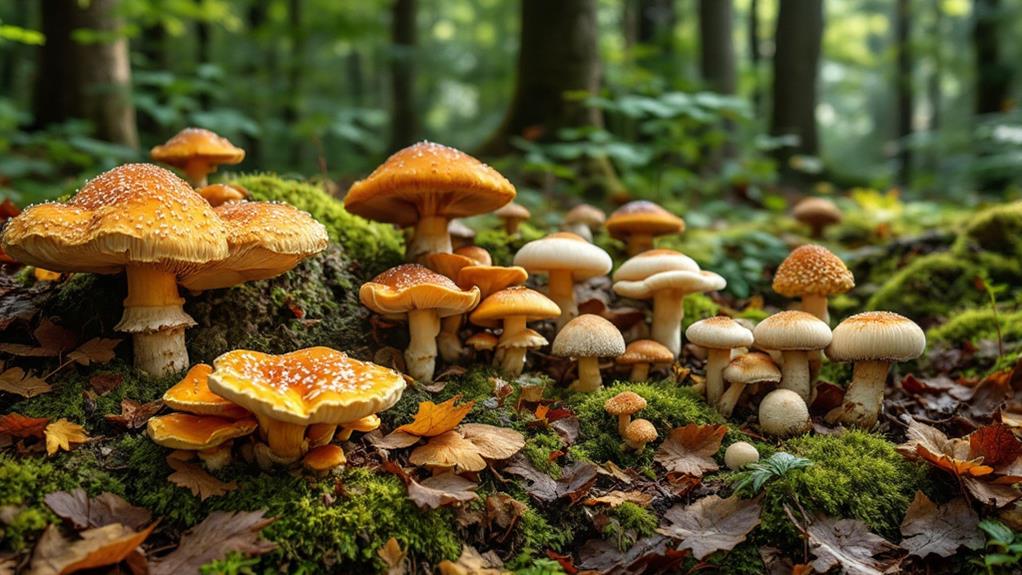
Having examined mushrooms prominent in Asian cuisine, let's now venture into the fascinating world of wild and foraged varieties. Imagine wandering through a forest, basket in hand, searching for these hidden gems. Chanterelle mushrooms, with their distinctive trumpet shape and apricot scent, are often foraged and celebrated in European cuisines, especially French dishes. Their lively color is a sight to behold.
Morel mushrooms, with their unique honeycomb appearance, are another wild mushroom beloved by foragers. Their nutty flavor makes them a springtime delicacy, though they're tough to cultivate, contributing to their allure. Black trumpet mushrooms are a gourmet's delight, known for their rich, smoky flavor. When caramelized, they enhance pasta and risottos to new culinary heights.
Hedgehog mushrooms, named for their spiky gills, are a safe and crunchy option to forage. Their nutty taste complements mixed mushroom stir-fries beautifully. Finally, matsutake mushrooms, although rare, are highly prized in Asian cuisines for their distinctive spicy aroma. They can command prices up to $1,000 per kilogram, making them a luxurious addition to any dish. Accept the adventure of foraging and uncover nature's gourmet offerings.
Mushrooms for Vegetarian Dishes
When crafting vegetarian dishes, mushrooms shine as versatile stars, offering a range of flavors and textures that can transform any meal. Portobello mushrooms are a fantastic choice when you need a meat substitute. Their large size and meaty texture make them perfect for grilling, stuffing, or creating a hearty vegetarian burger. You'll find that their robust presence satisfies even the most devout meat lovers.
Shiitake mushrooms are another excellent option, commonly used to enrich vegetarian dishes with their distinctive umami flavor. They work wonders in stir-fries, soups, and sauces, providing depth and complexity to plant-based recipes. A simple bowl of miso soup or a vegetable stir-fry can be enhanced to new heights with these flavorful fungi.
Consider these options for your next vegetarian dish:
- Portobello Burgers: Grill portobello caps with your favorite marinade for a delicious, savory burger.
- Shiitake Stir-Fry: Add sliced shiitakes to your vegetable stir-fry for an umami enhancement.
- King Oyster Tacos: Shred king oyster mushrooms for a unique taco filling.
Each mushroom variety offers a unique taste and texture, making it easy to craft satisfying vegetarian dishes that delight the palate.
Mushrooms With Unique Textures
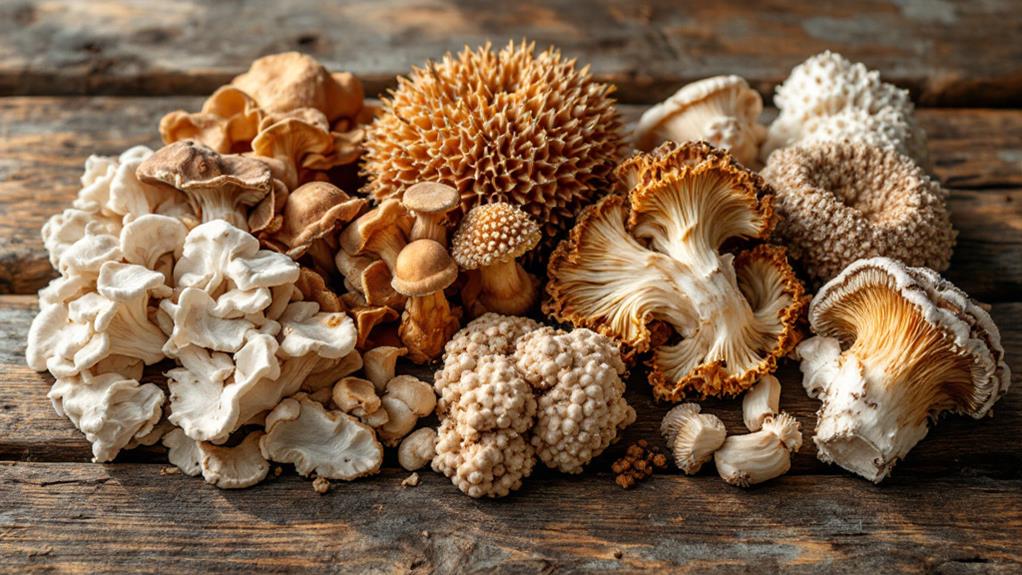
Exploring mushrooms' unique textures opens up a world of culinary possibilities that can improve your dishes to new heights. Start with Wood Ear Mushrooms, known for their thin, ear-shaped, and gelatinous texture. They're a staple in Asian cuisine, contributing a unique chewiness to soups and salads without overpowering flavors. Their subtle presence raises dishes with an intriguing mouthfeel.
Next, consider Hedgehog Mushrooms, which offer a crunchy, nutty texture akin to chanterelles. When cooked properly, these mushrooms provide a delightful bite, perfect for different dishes. They're safe to harvest, making them an excellent choice for adventurous cooks looking to experiment.
Lion's Mane Mushrooms, recognized by their shaggy, fuzzy appearance, boast a firm texture reminiscent of shellfish. They can be grilled or sautéed, providing a hearty bite that stands out in any dish. Their unique texture makes them a fantastic supplement to your culinary repertoire.
Seasonal Mushroom Availability
Mushroom foraging offers a rich tapestry of seasonal delights, each with its own prime harvest time. Spring ushers in morel mushrooms, a true seasonal delicacy. Found primarily from April to May, morels are keenly sought after by both foragers and chefs. These unique mushrooms thrive in the aftermath of rain, often near hardwood logs, contributing an earthy touch to your culinary endeavors.
As spring shifts to summer, chanterelle mushrooms make their golden appearance. Spanning late spring to early fall, these common mushrooms are a staple in European cuisine, cherished for their delicate flavor. Meanwhile, maitake mushrooms, or hen of the woods, become abundant in late summer in the eastern United States. They're a popular choice for Asian cooking, where their rich taste improves diverse dishes.
In the later months, from late summer to early fall, black trumpet mushrooms emerge in forested areas. Their smoky flavor and unique texture make them a prized find. Moreover, oyster mushrooms, although cultivated year-round, can be found in the wild during warm weather. They grow on hardwood logs, providing a delightful supplement to your menu.
To summarize:
- Morels: Spring (April-May)
- Chanterelles: Late spring to early fall
- Maitake: Late summer
Cooking Techniques for Mushrooms
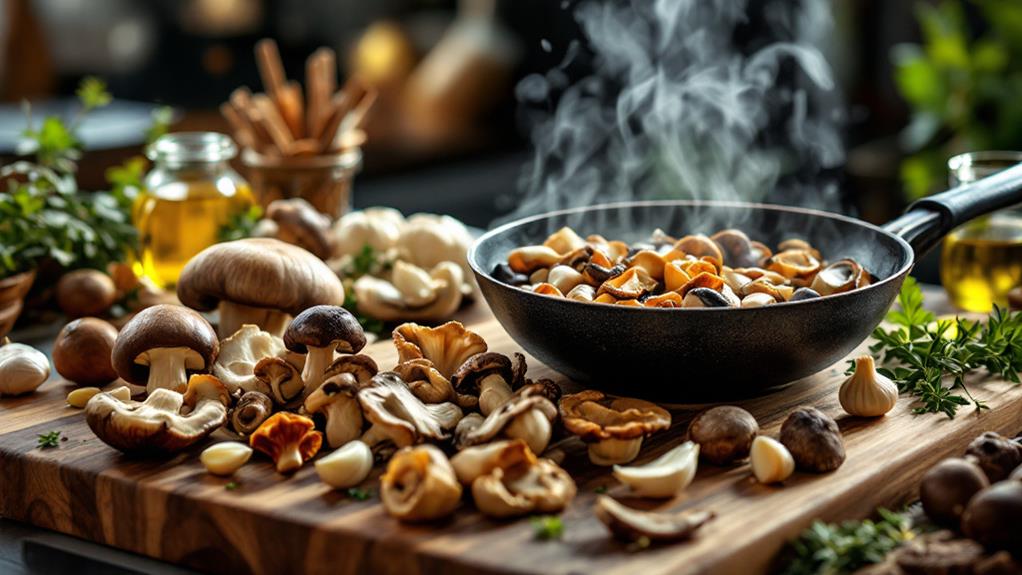
Sautéing mushrooms is a quick and effective way to improve their natural flavors. When you sauté shiitake or oyster mushrooms, add garlic and herbs to elevate their taste while maintaining their delightful texture. Just a few minutes in a hot pan is all it takes to transform these mushrooms into a savory delight.
If you're craving a meaty texture, try roasting portobello mushrooms. Their robust structure caramelizes beautifully, making them perfect for vegetarian burgers or stuffed creations. Simply season them well, pop them in the oven, and let the heat work its magic.
For a different approach, blanch enoki mushrooms briefly before tossing them into salads or stir-fries. This technique preserves their delicate crunch and mild flavor, adding a revitalizing element to your dishes.
Grilling king oyster mushrooms is another fantastic option. Slice them thickly and grill until they develop a smoky, charred flavor. They serve as a wonderful meat substitute, full of umami goodness.

